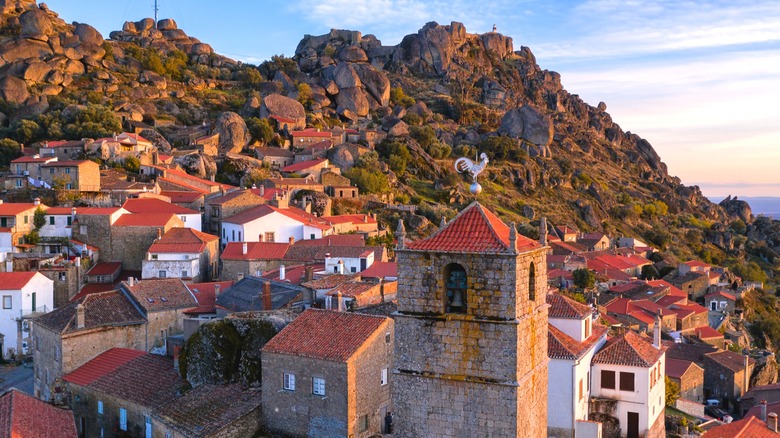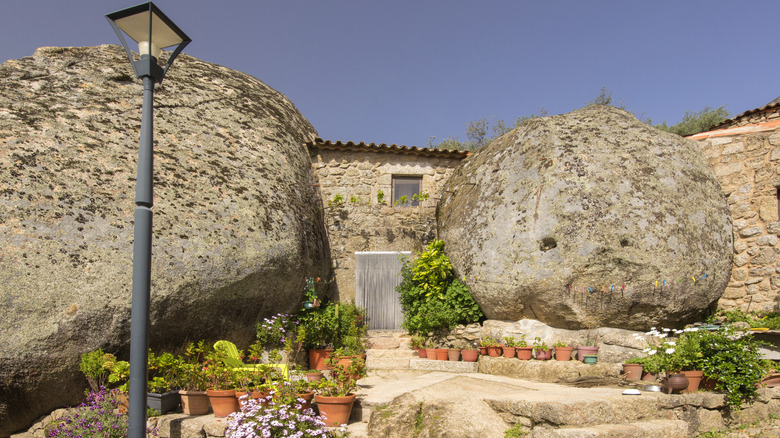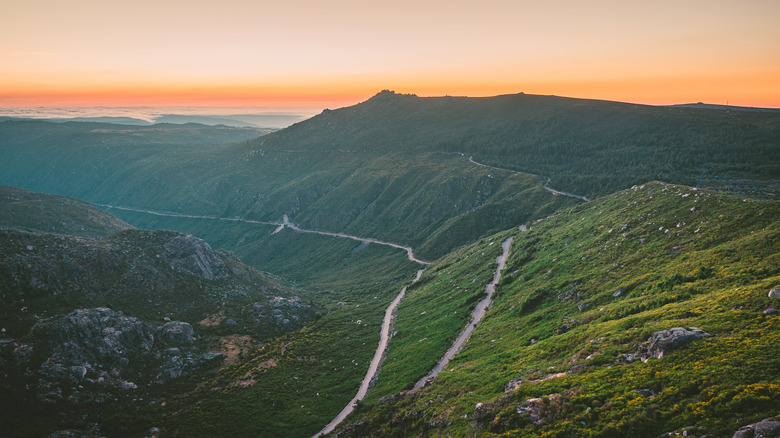Portugal's 'Most Portuguese Village' Is An Under-The-Radar Medieval Gem With Unique Rock Houses
While the Portuguese coastline often steals the show, home to breathtaking beaches and city breaks like Lisbon and Porto, the country's interior hides a few gems as well. Take Monsanto, a small village in central Portugal just 16 miles from the Spanish border. Known as the "Most Portuguese Village in Portugal," Monsanto is a fascinating hilltop town entirely built from stone. Some buildings are hewn directly out of massive granite boulders that populate the mountainside, giving a troglodytic feel to this charming town. But how did this unique stone village garner its lofty title?
In 1938, the right-wing regime Estado Novo (New State) sought to increase farming production by romanticizing rural life in Portugal. To encourage interest in a bucolic lifestyle, the state selected a dozen charming villages, of which Monsanto was awarded the prestigious title of "Most Portuguese Village in Portugal." With the title came several new laws, including limited development near the village, and the town still largely resembles its 1938 self. Discover the historical beauty of Monsanto, from castle ruins and stone churches to charming restaurants and taverns.
The best things to do in Monsanto
Monsanto is a small village, and there's no better way to appreciate its unusual beauty than on foot. While the town is little, it's the perfect day trip from nearby Coimbra, a spot Rick Steves calls a less-crowded mini Lisbon. Spend a few hours wandering the cobbled streets past red-roofed homes, massive boulders, and cave dwellings while hitting all the best sights. Don't miss the Torre do Lucano, the local clocktower crowned by a shining silver rooster, the symbol of Portugal, commemorating the town's victory in 1938.
Wind your way up the streets to the 12th-century hilltop fortress, Castelo de Monsanto. Located at the apex of Mount Monsanto, these ruins were once a defense point for the Knights Templar against invasion from the Spanish border. Explore the crumbling walls and boulders while taking in breathtaking 360-degree views of the countryside below. Just below the castle ruins sits the Capela de São Miguel, the ruins of a late 12th-century Romanesque chapel. An intriguing necropolis surrounds the chapel, with unusual tombs and sarcophagi carved directly into the stone and boulders on the mountainside.
After your hike up the hillside, refuel with a drink and petiscos at one of Monsanto's charming restaurants. Visitors love Taverna Lusitana, a quaint tavern carved into the rock face serving small plates. Try to snag a table on the outdoor terrace for epic views while enjoying a glass of chilled vinho verde.
Top sights near Monsanto
Just 7 miles east of Monsanto is another charming village with a fascinating history, Penha Garcia. Nestled into the mountainside, this little village is known for its trace fossils, impressions of early marine invertebrates colloquially called "painted snakes" for their twisting shape. The best place to spot these fossils is along the Rota dos Fósseis, the Fossils Route. This spectacular 1.7-mile loop takes hikers past the medieval Castelo de Penha Garcia, a dam and watermills, and finally through quartzite rocks with over 60 species of trace fossils.
Nature enthusiasts should check out the Serra da Estrela Natural Park, just over 50 miles northwest of Monsanto. This sprawling park is the largest nature reserve in the country and is home to Torre, the highest point in mainland Portugal at a staggering 6,539 feet. This tower's height is only topped by a mountain on the island of Pico, an uncrowded and exotic getaway in the Azores. Another highlight is the Zêzere Glacial Valley, a rocky U-shaped gorge popular among hikers with diverse flora and fauna and a glacial lagoon. While in the area, don't forget to sample Queijo Serra da Estrela, a soft and flavorful local cheese made from sheep's milk.


